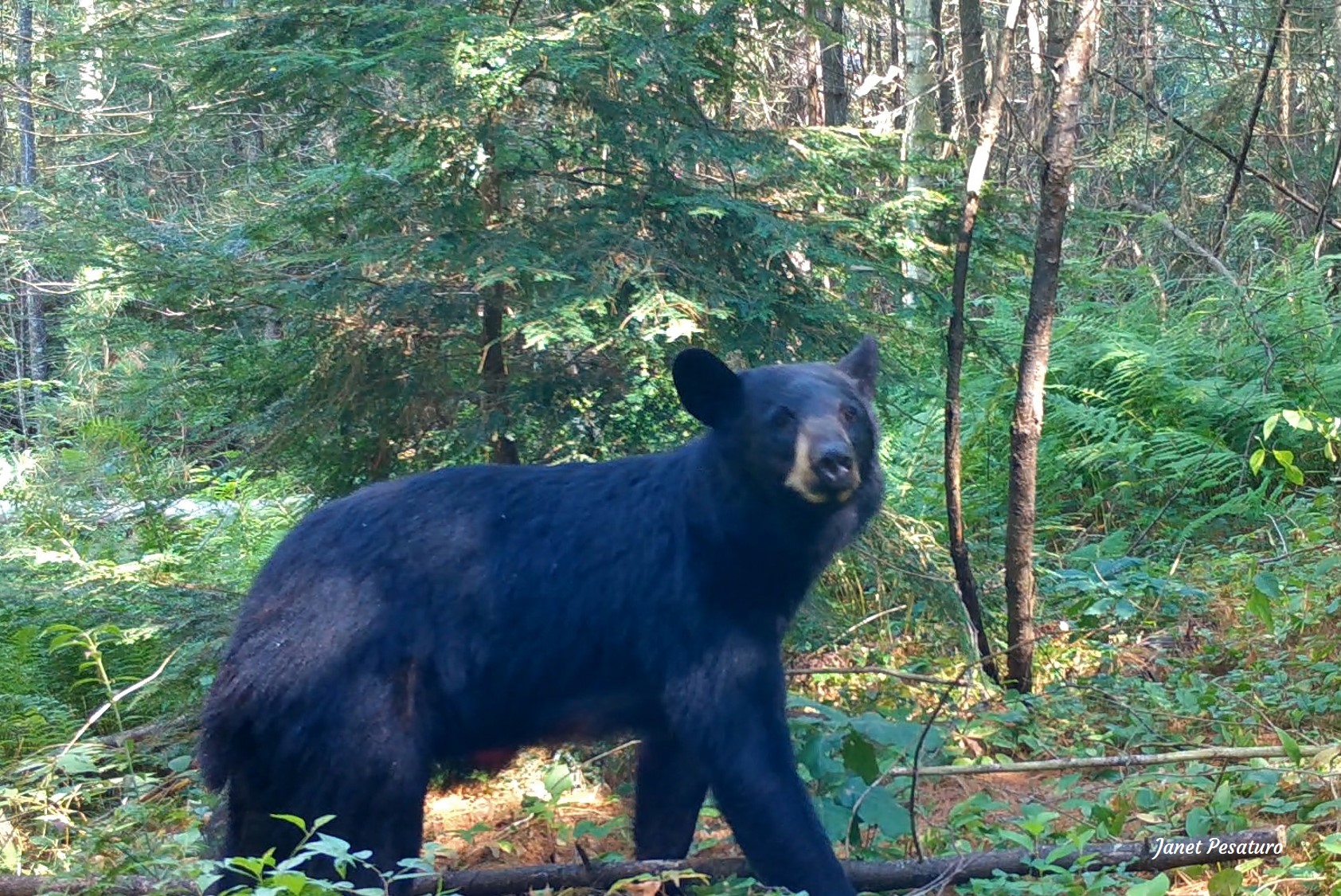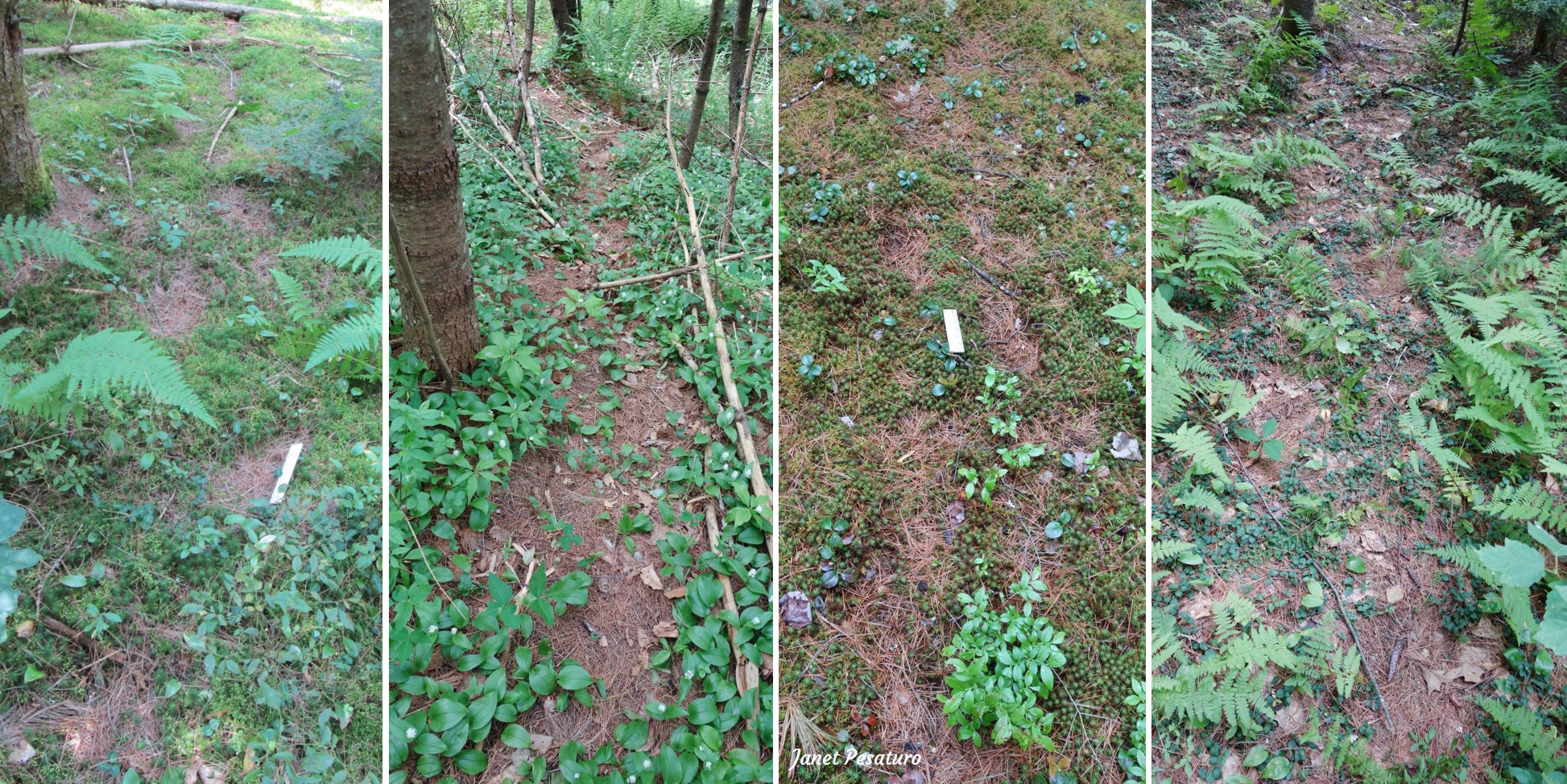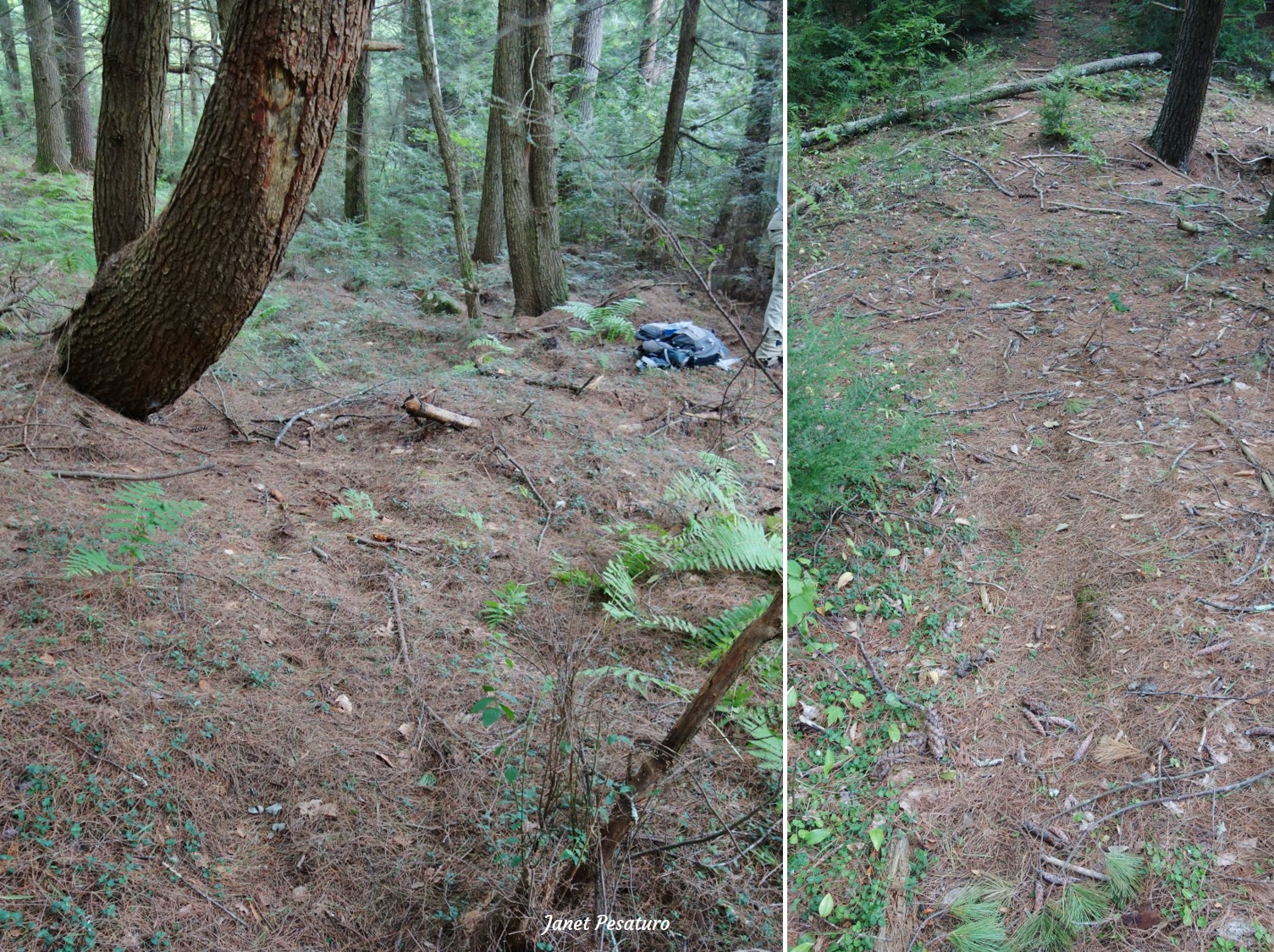Black Bear Marking Trails and Runs

Because clear foot prints are rarely present, the ability to recognize other bear sign is very helpful in tracking bears. A black bear marking trail, also called mark trail, stomp trail or ritual trail, is a series of worn ovals in an alternating pattern caused by bears stepping repeatedly in the same spots when they walk the trail. Sometimes when bears walk these trails, they use a stiff-legged, wide-based stomping gait, called a stomp walk or cowboy walk, as they punch and twist their feet into the worn spots. At other times bears merely step in the worn spots without stomping or twisting the feet. And sometimes what they do is in between: a bit stiffer than the normal relaxed walk, but without exaggerated stomping. In any case, bears are depositing scent from the bottoms of their feet but probably more so when they stomp and twist.
Identifying Marking Trails
The worn ovals of a stomp trail are easier to see in a substrate of shallow green vegetation such as moss because they will be brown depressions against a green background. However on bare soil, leaf litter or pine needles, the ovals are brown depressions in brown substrate, and so are difficult to see. The stomp trail sections are sometimes near bear marking trees, but not always. Often I can’t see anything significant about that part of the trail chosen for stomp marking.


Finding Black Bear Marking Trails
Start by looking for a wildlife trail because a marking trail is usually a short section of a much longer run. As you follow such a run, keep your eyes peeled for other bear sign, such as scats, torn up logs, and trees with claw marks or bite marks. I recently followed a half mile long bear run and within it there were several lengths of clear stomp marking. Each length was only about 10-20 feet in length. The rest of the run just looks like a plain trail but there were occasional marking trees and bear scats along the way. A short distance off the run were a couple of torn up logs.
A good place to look for a run that may contain sections of stomp trail is along a wetland. So far all of the well used bear runs with sections of stomp marking I know of follow large wetland systems. This is no surprise because wetlands provide many food sources as well as water for drinking and cooling off. I’ve yet to find a bear run with stomp marking in an upland setting, but bears do create them between any important resources.
Trail Cameras on Stomp Trails and Bear Runs
Black bear marking trails and runs are often productive places for trail cameras because bears tend to use them regularly and you can observe interesting behaviors. At a stomp trail you can record bears marking the trail. At a marking tree, which is usually along a stomp trail, you might observe scent marking behaviors on both the tree and the trail. Look for other interesting features along the run, too, such as snags, logs and berry bushes, where bears might stop and forage.
Here are some of my videos from cameras placed along bear runs. All videos captured in Massachusetts.
Video 1
The first video shows a bear scent marking the stomp trail (in color), then at a later date (in black and white) just walking normally. Watch how the first bear uses a wide based gait and straddles the small conifers as it walks the trail. There is no exaggerated stomping and twisting of the feet, but the bear is clearly altering its gait for the trail. Straddling the conifers probably indicates it is scent marking by urinating on the trees. Then, in the black and white clip, the bear just casually walks along in a typical relaxed gait. It’s not even stepping in the foot fall depressions and it does not straddle the conifers.
Video 2
The second video is from a stomp trail in a different location and shows that multiple bears and other species use these trails. In addition to bears, a moose, white-tailed doe and fawn, and a buck, use the trail.
Video 3
The third video is a compilation of clips from cameras stationed at 3 different spots along a single bear run, essentially following each bear through the run. One camera is placed at a stomp trail in a small clearing, one is facing a log crossing the run, and the other is targeting a marking tree along another stomp trail section. Notice how all of the animals step on the log or brush over it or, in the case of the bobcat, sits on the log. They all leave scent behind, so it’s not surprising when one of the cubs stops at the log for a good long sniff.
One caution about placing cameras on bear runs: Bears are known for messing with trail cameras and because they are so strong, they can do significant damage. So either secure the camera in a metal security box, or be prepared for damage.
Do you have a question or comment about black bear marking trails? Feel free to leave it in the comment section below!
Sources
DeBryun, T. D. Walking with Bears: One Man’s Relationship with Three Generations of Wild Bears. New York, NY: The Lyons Press, 1999.
Elbroch, M. and C. McFarland. Mammals Tracks & Sign: A Guide to North American Mammals. 2nd Edition. Guilford, CT: Stackpole Books, 2019.

As always, Janet, I sat riveted to the screen through it all. Can’t thank you enough for continuing to present such well-organized information, accompanied by engaging footage to reinforce the concepts within. Keep ’em coming, I say! They’re like manna from heaven, especially during this pandemic.
Hi Lori! Thanks so much for letting me know you enjoy these posts. Knowing that gives me reason to keep writing. Have you been getting out to track this summer? Bob and I have been doing quite a bit since it’s one of the safest things to do beyond the backyard.
Janet, very informative article. This year I have located more torn up stumps in MA than in any prior year camera trapping. Now the homework ! I’m eager to see if I can locate a stomp trail.
Thanks for sharing
Jim
Hi Jim! Bet you’ll find a stomp trail before the bears go down. You seem to know where the bear hot spots are. I’ve seen just a couple of torn up logs but as for overall bear sign, I’ve seen more this year than ever before. Honestly I think the reason is the pandemic. Wandering through the wilderness is one of the few safe ways to get out of the house, so I’ve spent more time tracking this summer than usual.
Fascinating! I’m going to buy your book, I have some bears that visit my yard,…my recent visitor emptied out 4 suet feeders, they use there feet to hold them & paws to pry open
They have also in past helped themselves to my hummingbird feeders
Hi Sue, I’m glad you find this interesting, and hope it inspires you to look for bear sign. Sounds like that might not be too hard where you live. And not to be preachy, but I do want to make sure you understand that bird feeders are involved in a majority of human-bear conflicts in some states. Bears that raid bird feeders are one step closer towards becoming bold around people and people’s stuff, and when people start complaining about it, the bear often loses its life. So in bear country it’s recommended that feeders be out only while bears are hibernating. OK sermon over. Thanks for commenting and I hope you continue to enjoy learning about wildlife!
Thank you Janet! I had the same reaction to the bird feeding above. Great videos! Finally bought three more trail cams so I can get some trail passage continuity. I’m the “Please don’t feed the bears” grump in my neck of the woods. My biggest concern is keeping the bears off my compost bin, peach trees and chickens. The local bobcat seems to have been trained by the electric chicken fencing. It walked up the driveway, saw the chickens headed under the deck and just kept on walking! Wonder if it thinks my chickens fenced or not are charged. The funniest thing was seeing a bold chicken run right back out and look around the corner of the garage to make sure the bobcat kept on going.
Funny you mentioned the well trained bobcat. We had chickens for years, with coop and run encircled with an electric fence. We turned the fence off and let the hens roam freely during their golden years so they could enjoy their remaining time, wondering how long it would take the local predators to catch on. A dog got one but wild mammalian predators didn’t touch them for 1-2 years. I even got trail cam pics of a bobcat sitting at the open door to the run and looking in. Amazingly, it just got up and walked away. I concluded that it must have been so well trained by the electric wire to avoid our chickens, that there would be no bobcat strike until the next generation of bobcats. 1-2 yrs later a hen went missing and days after that I saw a juvenile bobcat walk across the yard.
Once, on a narrow hogback ridge about 1,000 feet above the valley floor I found and followed a stomp trail in dry leaves. The depressions were quite noticeable and continued for several hundred feet. Unfortunately, the photos I took failed to really show the depressions — probably since it was a dark cloudy day with very flat light.
Very cool. Not surprising the photos didn’t show the depressions. I took a lot of pics before getting one that *almost* shows them in brown substrate. I have read that stomp trails can be found on ridge tops but have never found one in such a location. Do you know if there was an important food source up there? Mast producing trees perhaps?
The forest on the ridge was predominantly chestnut oak and red oak, but I don’t recall whether it was a good acorn year for either species. However, it was in mid-November after the leaves and acorns would have fallen. The north side of the ridge was predominantly a hemlock forest, in northcentral Pennsylvania bears seem to prefer to den where there are hemlock so the bear may have also been examining den sites in the weeks before actually going to den.
So interesting, Woody. Now finding a ridge top stomp trail is on my bucket list 🙂
I always know when spring is here as the bear trek through our back yard. Time to take the feeders down. I try to do a lot of tracking in the winter when tracks are easy to see, and wonder, do you teach any tracking courses? I live in Mason, NH so you are close by and have taken a couple of courses with Dan Gardoqui but would love to take more. I also am a total failure when it comes to my game cameras. I cannot seem to get them to work. Directions followed et al. aarrgghhh.
Hi Miki, this year I am taking a break from teaching tracking due to the pandemic and family reasons, but may resume them next fall. Check under the “Wildlife Education Programs” tab in this website for updates next fall.
Pingback:Black Bear Straddle Marking - Winterberry Wildlife
Pingback:Trail Camera Placement at Stream
Hi Janet,
You start off using the terms bear run, stomp trail and ritual trail interchangeably as I have done in the past. This year, for the first time, I am starting to see a reason to be more selective in which term I use and I’m interested what your thoughts are on this.
For example, I found a trail of continuous depressions of bear feet stomps that traveled through woods. This trail was not on the edge of a wetland, but a wetland was nearby. There were two or three separate trees that had been marked along this trail by an upright bear, however the trail was more a continuous trail of stomps than anything else. Although it had deviation, the heading was constant.
If I’m remembering correctly, only one or two foot placements were missing (and tracker error should be considered here). I can’t estimate distance with any consistency but I would guesstimate the trail at least 1/4 mile long, or longer.
For the first time I felt “ritual trail” would be the more appropriate term to use with this long trail through the woods, with so few trees marked along the way.
And use “stomp trail” for shorter trails next to trees that were bear marked that seem to define borders of territories or wetlands that bears want to claim as their own. (That other bears then overmark).
I would be interested in your thoughts on this.
Hi Mo, very interesting observations and thoughts about the terminology. I’m beginning to think that “stomp trail” is a poor term for any of these bear trails of worn ovals. As I have seen with trail cams, they often do not use the stomping cowboy gait even at those sections of the trail near mark trees.
Conversely, they do occasionally use the stomping gait in sections of the trail not near mark trees, so I’m not sure we can say any particular portion of the trail qualifies any more or less as a “stomp trail”.
Further, sometimes bears stomp walk where there is no trail of worn ovals.
Black bear and grizzly stomp trails were discussed recently in an online tracking group, and I learned that very long stomp trails (miles?) are all over Alaska. And, people who have observed bears on these trails say that bears often walk them without using the stomping gait.
So here are my thoughts right now (though always changing, as I learn more):
1. “Stomp trail” is a misnomer that probably caught on because people assumed bears always stomp when they walk these trails. But now we know that is not true.
2. Actual “stomping” may have little to do with creation of these trails of worn ovals. Repeated stepping in the same spots is probably enough to create them.
3. We don’t know the meaning of these trails.
4. We don’t know meaning of the stomping gait.
5. Whatever the reason, the fact that bears step in the same footfalls repeatedly does seem ritualistic, so ritual trail may be a better term for all of these trails. In the past I rejected this term because I heard it used to promote the idea that bears create these trails for “religious” reasons.
6. Maybe “mark trail” or “marking trail” is an even better term, because all bears are leaving scent behind, whether or not that is their conscious intention, and the fact that they step in the same spot where other bears have stepped is reminiscent of the concept of over-marking.
Hi Janet,
Thanks for sharing your thoughts and the current information at hand on this topic of sign and trails that bears leave on the ground after their passage. These trails bears continue to make over long distances intrigue me. I have found that several different bears follow these trails, and yet the woods would have allowed the bears to veer off this trail easily enough. But they don’t. And by my eye, they seem compelled to follow these trails.
We have so much more to learn.
Thanks again for your videos and thoughts.
Yes, they do seem compelled. Following the trail doesn’t surprise me (most people follow human trails without straying off very often) but their stepping in the same spots for long distances is curious.